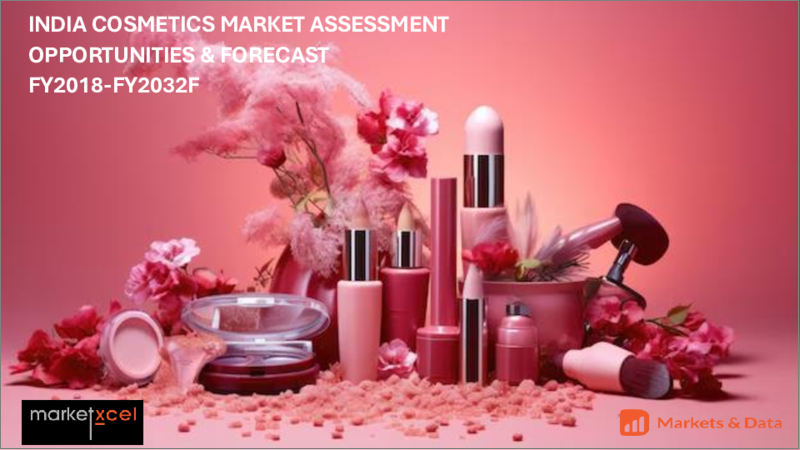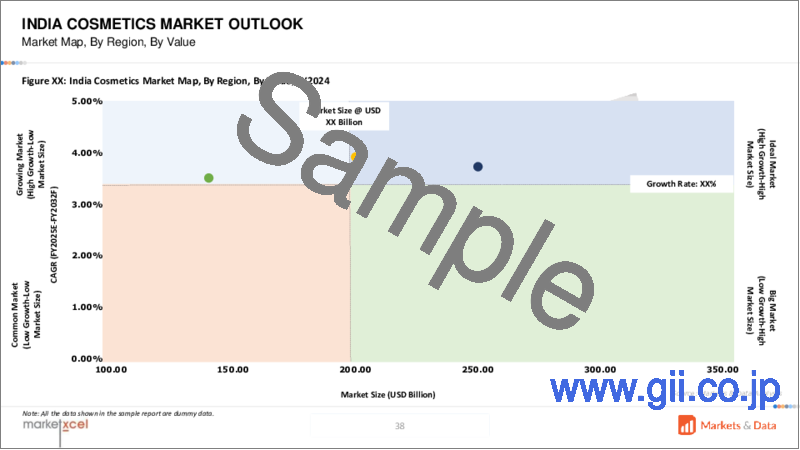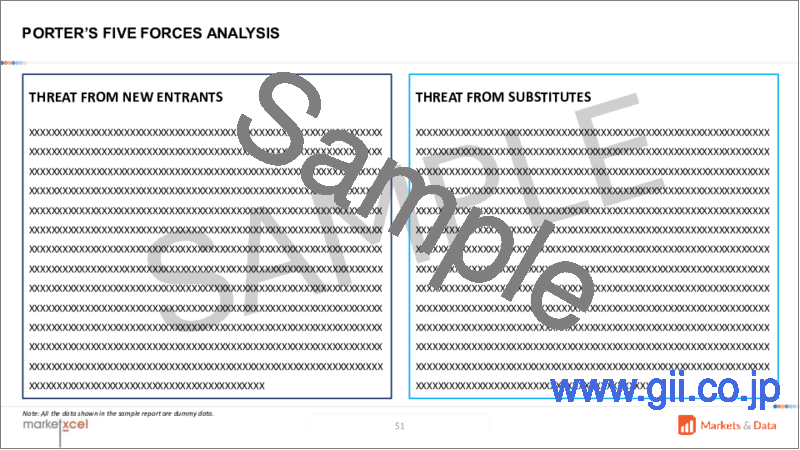|
|
市場調査レポート
商品コード
1661662
インドの化粧品市場の評価:製品カテゴリー別、男女別、エンドユーザー別、流通チャネル別、地域別、機会および予測、2018~2032年India Cosmetics Market Assessment, By Product Category, By Gender, By End-user, By Distribution Channel, By Region, Opportunities, and Forecast, FY2018-FY2032F |
||||||
カスタマイズ可能
|
|||||||
| インドの化粧品市場の評価:製品カテゴリー別、男女別、エンドユーザー別、流通チャネル別、地域別、機会および予測、2018~2032年 |
|
出版日: 2025年02月25日
発行: Markets & Data
ページ情報: 英文 135 Pages
納期: 3~5営業日
|
全表示
- 概要
- 図表
- 目次
インドの化粧品市場規模は、2024年度に172億7,000万米ドルと評価され、中間層人口の増加、パーソナルケアにおけるオーガニックや天然成分へのシフト、NykaaやPurplleなどのオンライン小売プラットフォームの拡大など、いくつかの要因によって、2025年度から2032年度までの予測期間においてCAGR 6.8%で292億3,000万米ドルに成長すると予想されています。インドは化粧品の最も優れた市場の一つであり、あらゆるカテゴリーの様々なブランドにとって成長の可能性を秘めています。ミレニアル世代、Z世代、Y世代を中心に14億人以上の人口を抱えるインドは、化粧品に対する旺盛な欲求を持ち、国際的なブランドにとって有利な市場となっています。
化粧品業界は現在、D2C(Direct-to-consumer:消費者への直接販売)という新しいトレンドを目の当たりにしています。35歳以下の若年層が大半を占めるインドは、化粧品ブランドにとって重要なターゲット市場です。国際的な化粧品ブランドは、eコマース大手との長期的な独占提携を通じて、インド市場をターゲットにしています。それは、中間層や富裕層の購買力が高まっていることと、eコマースが市場の認知度向上や浸透に役立つ可能性があることの2点を理解しているからです。
美容製品におけるテクノロジーは、ブランドが市場で成功するために不可欠なツールになりつつあります。例えば、Tata Groupは若い顧客を引き込むため、デジタル・スキンチェックやバーチャル・メイクアップ・アプリケーション用のキオスクを備えた「ビューティ・テック」ストアを少なくとも20店舗オープンする予定です。Sugar Cosmeticsは、顧客体験を向上させるため、拡張現実(AR)に多額の資金を投じています。Myntra Beautyは製品検索、肌分析、バーチャル試着サービスを開始する予定で、NykaaはAIを活用したバーチャル試着プラットフォームModiFaceを発表する予定です。
目次
第1章 調査手法
第2章 プロジェクトの範囲と定義
第3章 エグゼクティブサマリー
第4章 顧客の声
- 人口統計(年齢/コホート分析- ベビーブーマー世代、ジェネレーションX、ミレニアル世代、ジェネレーションZ、性別、所得- 低所得、中所得、高所得、地域、国籍など)
- 市場認識と製品情報
- ブランド認知度とロイヤルティ
- 購入決定時に考慮される要素
- ブランド名
- パックサイズ
- 価格
- カスタマイズオプション
- 梱包タイプ
- 製品の品質
- オーガニック製品への傾倒
- プロモーションオファーと割引
- 購入目的(個人使用、贈答)
- 購入頻度
- 購入媒体
- ブランドアンバサダーやインフルエンサーマーケティングが製品/ブランドの浸透に果たす役割
第5章 インドの化粧品市場の見通し、2025年~2032年
- 市場規模と予測
- 金額別
- 数量別
- 製品カテゴリー別
- スキンケア
- ヘアケア
- ネイルケア
- メイクアップ
- フレグランス
- バス&ボディ
- その他
- 男女別
- 男性
- 女性
- ユニセックス
- エンドユーザー別
- 商業施設
- ホテル
- スパ
- 美容室
- カラー化粧品および美容サービスプロバイダー
- その他
- 個人ユーザー
- 商業施設
- 流通チャネル別
- オンライン
- オフライン
- 小売店
- 卸売チャネル
- ディーラー/販売店
- その他
- 地域別
- 北部
- 南部
- 東部
- 西部と中部
- 企業別市場シェア(%)、2024年度
第6章 市場マッピング、2024年
- 製品カテゴリー別
- 男女別
- エンドユーザー別
- 流通チャネル別
- 地域別
第7章 マクロ環境と産業構造
- 供給需要分析
- 輸入輸出分析
- バリューチェーン分析
- PESTEL分析
- 政治的要因
- 経済システム
- 社会的影響
- 技術の進歩
- 環境への影響
- 法令遵守と規制ポリシー(法定機関を含む)
- ポーターのファイブフォース分析
- サプライヤーの力
- 買い手の力
- 代替の脅威
- 新規参入の脅威
- 競争企業間の敵対関係
第8章 市場力学
- 成長促進要因
- 成長抑制要因(課題、制約)
第9章 主要企業の情勢
- 市場リーダー上位5社の競合マトリックス
- 上位5社の市場リーダーの市場収益分析(%、2024年度)
- 合併および買収/合弁事業(該当する場合)
- SWOT分析(市場企業5社向け)
- 特許分析(該当する場合)
第10章 価格分析
第11章 ケーススタディ
第12章 主要企業の展望
- Hindustan Unilever Limited
- 会社概要
- 主要経営陣
- 製品とサービス
- 財務状況(報告通り)
- 主要市場への注力と地理的プレゼンス
- 最近の動向
- L'Oreal SA
- The Procter &Gamble Company
- The Estee Lauder Companies Inc.
- Modi Enterprises
- Bio Veda Action Research Co.
- Lotus Herbals Ltd
- The Himalaya Drug Company
- The Shahnaz Husain Group
- WOW Skin Science
上記の企業は市場シェアに基づいて注文を保留しておらず、調査作業中に入手可能な情報に応じて変更される可能性があります。
第13章 戦略的提言
第14章 調査会社について・免責事項
List of Tables
- Table 1. Competition Matrix of Top 5 Market Leaders
- Table 2. Mergers & Acquisitions/ Joint Ventures (If Applicable)
- Table 3. About Us - Regions and Countries Where We Have Executed Client Projects
List of Figures
- Figure 1. India Cosmetics Market, By Value, In USD Billion, FY2018-2032F
- Figure 2. India Cosmetics Market, By Volume, In Unit Thousand, FY2018-2032F
- Figure 3. India Cosmetics Market Share, By Product Category, In USD Billion, FY2018-2032F
- Figure 4. India Cosmetics Market Share, By Gender, In USD Billion, FY2018-2032F
- Figure 5. India Cosmetics Market Share, By End-user, In USD Billion, FY2018-2032F
- Figure 6. India Cosmetics Market Share, By Distribution Channel, In USD Billion, FY2018-2032F
- Figure 7. India Cosmetics Market Share, By Region, In USD Billion, FY2018-2032F
- Figure 8. By Product Category Map-Market Size (USD Billion) & Growth Rate (%), FY2024
- Figure 9. By Gender Map-Market Size (USD Billion) & Growth Rate (%), FY2024
- Figure 10. By End-user Map-Market Size (USD Billion) & Growth Rate (%), FY2024
- Figure 11. By Distribution Channel Map-Market Size (USD Billion) & Growth Rate (%), FY2024
- Figure 12. By Region Map-Market Size (USD Billion) & Growth Rate (%), FY2024
India Cosmetics Market size was valued at USD 17.27 billion in FY2024 which is expected to grow to USD 29.23 billion in FY2032 with a CAGR of 6.8% for the forecast period between FY2025 and FY2032 owing to several factors such as growing middle class population, shift towards organic and natural ingredients in personal care and expansion of online retail platforms such as Nykaa and Purplle. India being one of the finest markets for cosmetics has a growth potential for various brands in any category. A large population of more than 1.4billion, dominated by Millennials, Gen Z and Gen Y have huge appetite for cosmetics available in the market, makes it lucrative for international brands.
Cosmetic industry is currently witnessing a new trend where D2C (Direct-to-consumer) is picking up the pace and brands are coming up with innovate ideas to engage with customers directly. India, a country of young population with majority of them below age of 35, is a key target market for cosmetic brands. International cosmetic brands are targeting on the Indian market through long-term exclusive partnerships with e-commerce giants as they have understood two things: growing buying capacity of the middle and rich class and the potential of e-commerce to help them gain visibility and penetrate the market.
Technology in beauty products is becoming an essential tool for brands to succeed in the market. For example, to draw in young customers, the Tata Group plans to open at least 20 "beauty tech" stores with kiosks for digital skin checks and virtual makeup applications. Sugar Cosmetics is spending a lot of money on augmented reality (AR) to improve the customer experience. Myntra Beauty plans to launch a product finder, skin analyzer, and virtual try-on service, and Nykaa will debut ModiFace, an AI-powered virtual try-on platform.
Emergence of Organic & Natural Cosmetics
Growth of natural and organic beauty care has been on an upward swing as consumers are more inclined towards products which are chemical free and are gentler on skin and hair. Not just in the ingredients of the products, manufacturers are also improving on their packaging and switching from traditional plastic packaging to eco-friendly options by opting for materials that are recyclable or biodegradable. For example,, Soultree, a Gurgaon based ayurvedic cosmetic brand uses biodegradable materials in their packaging by replacing plastic tapes with paper tapes and inner packaging with honeycomb paper. Not just the packaging and product's ingredients are natural, the company has ensured to go natural even in the infrastructure of their outlet that is India's first 100% solar powered beauty and wellness store in Gurugram. The construction of the store is done using sustainable and biodegradable materials, non-plastic fixtures and reclaimed wood.
Growing Younger Population, Social Gathering Propels Market Demand
India is one of the flourishing hotspots for cosmetics and the large consumer base is attributed to increasing consumer spending power, rising middle class and upper middle-class population, growing women workforce, increase in social gatherings and growing awareness about skin care products. Both men and women are becoming highly conscious about their personal care and hygiene. The desire to purchase advanced skin care products that improve the skin coupled with young population's increasing inclination towards colour cosmetics is surging the demand of overall cosmetics market in India in years to come. Consumer spending in India rose to USD 303.1 billion (INR 24.77 trillion) in the last quarter of 2022, from USD 281.44 billion (INR 23 trillion) in the previous quarter.
Skin Care Products Dominate Market Growth
Indian cosmetics market is currently growing with significant momentum as there is growing consumer awareness of the skin and rising demand for more tailored skincare solutions. This growth can be contributed to changing consumer preferences, higher disposable incomes, and increased emphasis on personal grooming and wellness. The consumers are looking for more natural and organic products, with an influence of social media and celebrities. With an easy availability of a variety of skincare products, the expansion of e-commerce platforms also boosts market growth. Diverse landscapes of local and international brands have allowed the Indian skincare market to keep innovating, catering to unique consumer needs in terms of promoting holistic well-being and sustainability.
For instance, in December 2024, Hydrinity Accelerated Skin Science, Hydrinity LLC, a professional skincare brand, has partnered with Photonence India Private Limited to expand its presence into the Indian market. This collaboration aims to leverage Photonence's distribution network and expertise in the healthcare industry to introduce Hydrinity's hyaluronic acid-based products in India. The Indian skincare market is projected to grow significantly, presenting a substantial opportunity for Hydrinity's innovative skincare solutions.
Government Regulations
The Drug and Cosmetic Act 1940 and rules 1945 has laid down stringent provisions pertaining to the import, manufacturing and Sale & distribution of cosmetics. Animal cruelty is a serious issue for Indian government as products that have been tested in animals has been restricted for imported in India. It is also prohibited to manufacture or import cosmetics that contain toxic metals and minerals like hexachlorophene, lead, arsenic and mercury compounds. Time to time these regulations have been updated to meet the changing environment and protect customer's interest.
Also, a license needs to be attained from the state regulatory authority (States foods and Drug Administration) for manufacturing of cosmetics. This state regulatory authority is appointed by the state government to manufacture any cosmetic specified under Schedule M-II of the Act for its sale/distribution.
Grooming isn't limited to Women
Men demographic segment of India is witnessing splendid growth for beauty and cosmetic products which are dubbed and advertised as grooming products for men. After effects of Covid-19 and influence of social media have caused men to become more conscious regarding their well-being and looks. Brand advertising also played an important role for men beauty by promoting beauty of all and normalizing self-care. Unlike women who follow multiple step skin care routine, men address their issues directly by using products for issues like acne, dryness, oily skin, etc. Facial hair care has found a niche space in the grooming segment for men who want to maintain good and nice beard and hair styles.
Impact of COVID-19
The entire beauty industry was hit hard by the pandemic and in line with the same, there was a significant decline in the demand for cosmetic products. The personal hygiene products faced an increase in demand as consumers became more aware and conscious for the self-care.
However, when the Indian economy started reshaping again and restrictions were removed cosmetic industry displayed high growth rate and never looked back. After effects of COVID-19 saw changed brand strategy with focused D2C strategy and increase in ayurvedic and organic cosmetics demand from customer and more attention of men toward grooming.
Key Players Landscape and Outlook
Indian market for cosmetics is dominated by multinational companies but owing to a huge population base and a rise in middle class segment, many domestic manufacturers are also able to mark their significant presence in the country's cosmetic market. With growing demand for natural, cruelty-free and organic beauty products, many dermatologists and cosmetologists are also entering into manufacturing of skincare products for the highly health conscious and environment friendly consumers.
With changing dynamics, many Indian startups, especially the online retail platforms are driving the expansion of cosmetics market in India. Nykaa which stared as an e-commerce company for cosmetics has now opened it retail stores in 45 cities in India, reaching a total of 140+ stores across the country.
Table of Contents
1. Research Methodology
2. Project Scope & Definitions
3. Executive Summary
4. Voice of Customer
- 4.1. Demographics (Age/Cohort Analysis - Baby Boomers and GenX, Millenials, Gen Z; Gender; Income - Low, Mid and High; Geography; Nationality; etc.)
- 4.2. Market Awareness and Product Information
- 4.3. Brand Awareness and Loyalty
- 4.4. Factors Considered in Purchase Decision
- 4.4.1. Brand Name
- 4.4.2. Pack Size
- 4.4.3. Price
- 4.4.4. Customisation Options
- 4.4.5. Packaging Type
- 4.4.6. Product Quality
- 4.4.7. Inclination Towards Organic Products
- 4.4.8. Promotional Offers & Discounts
- 4.5. Purpose of Purchase (Personal Use, Gifting)
- 4.6. Frequency of Purchase
- 4.7. Medium of Purchase
- 4.8. Role of Brand Ambassador or Influencer Marketing on Product/Brand Absorption
5. India Cosmetic Market Outlook, FY2025-FY2032
- 5.1. Market Size & Forecast
- 5.1.1. By Value
- 5.1.2. By Volume
- 5.2. By Product Category
- 5.2.1. Skin Care
- 5.2.2. Hair Care
- 5.2.3. Nail Care
- 5.2.4. Make-Up
- 5.2.5. Fragrances
- 5.2.6. Bath & Body
- 5.2.7. Others
- 5.3. By Gender
- 5.3.1. Male
- 5.3.2. Female
- 5.3.3. Unisex
- 5.4. By End-user
- 5.4.1. Commercial Establishments
- 5.4.1.1. Hotels
- 5.4.1.2. Spas
- 5.4.1.3. Beauty Salons
- 5.4.1.4. Colour Cosmetics and Beauty Service Provider
- 5.4.1.5. Others
- 5.4.2. Individual Users
- 5.4.1. Commercial Establishments
- 5.5. By Distribution Channel
- 5.5.1. Online
- 5.5.2. Offline
- 5.5.2.1. Retail Stores
- 5.5.2.1.1. Brand Stores
- 5.5.2.1.2. Kiosks
- 5.5.2.1.3. Multi-Brand Outlets
- 5.5.2.1.4. Pharmacies/Drug Stores
- 5.5.2.1.5. Speciality Salons
- 5.5.2.1.6. Others
- 5.5.2.2. Wholesale Channels
- 5.5.2.3. Dealers/Distributors
- 5.5.2.4. Others
- 5.5.2.1. Retail Stores
- 5.6. By Region
- 5.6.1. North
- 5.6.2. South
- 5.6.3. East
- 5.6.4. West & Central
- 5.7. By Company Market Share (%), FY2024
6. Market Mapping, FY2024
- 6.1. By Product Category
- 6.2. By Gender
- 6.3. By End-user
- 6.4. By Distribution Channel
- 6.5. By Region
7. Macro Environment and Industry Structure
- 7.1. Supply Demand Analysis
- 7.2. Import Export Analysis
- 7.3. Value Chain Analysis
- 7.4. PESTEL Analysis
- 7.4.1. Political Factors
- 7.4.2. Economic System
- 7.4.3. Social Implications
- 7.4.4. Technological Advancements
- 7.4.5. Environmental Impacts
- 7.4.6. Legal Compliances and Regulatory Policies (Statutory Bodies Included)
- 7.5. Porter's Five Forces Analysis
- 7.5.1. Supplier Power
- 7.5.2. Buyer Power
- 7.5.3. Substitution Threat
- 7.5.4. Threat from New Entrant
- 7.5.5. Competitive Rivalry
8. Market Dynamics
- 8.1. Growth Drivers
- 8.2. Growth Inhibitors (Challenges and Restraints)
9. Key Players Landscape
- 9.1. Competition Matrix of Top Five Market Leaders
- 9.2. Market Revenue Analysis of Top Five Market Leaders (in %, FY2024)
- 9.3. Mergers and Acquisitions/Joint Ventures (If Applicable)
- 9.4. SWOT Analysis (For Five Market Players)
- 9.5. Patent Analysis (If Applicable)
10. Pricing Analysis
11. Case Studies
12. Key Players Outlook
- 12.1. Hindustan Unilever Limited
- 12.1.1. Company Details
- 12.1.2. Key Management Personnel
- 12.1.3. Products & Services
- 12.1.4. Financials (As reported)
- 12.1.5. Key Market Focus & Geographical Presence
- 12.1.6. Recent Developments
- 12.2. L'Oreal S.A.
- 12.3. The Procter & Gamble Company
- 12.4. The Estee Lauder Companies Inc.
- 12.5. Modi Enterprises
- 12.6. Bio Veda Action Research Co.
- 12.7. Lotus Herbals Ltd
- 12.8. The Himalaya Drug Company
- 12.9. The Shahnaz Husain Group
- 12.10. WOW Skin Science
Companies mentioned above DO NOT hold any order as per market share and can be changed as per information available during research work





